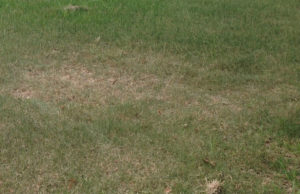Dryer Weather Causes Brown Spots in Lawns
 While some parts of the country are dealing with excess rainfall, other regions have been especially dry. The dryer weather can make the slightest irrigation deficiencies or root system deficiencies show up as wilted, browning areas of turf.
While some parts of the country are dealing with excess rainfall, other regions have been especially dry. The dryer weather can make the slightest irrigation deficiencies or root system deficiencies show up as wilted, browning areas of turf.
For the next month or two, dry soil is a likely cause of brown spots in turf; dry soil is not the only potential cause, but it is a highly likely cause.
Determining if dry soil is the cause of brown areas of turf can be simple, but is commonly overlooked. Landscape professionals will dig through the turf and to determine if the soil is dry in the root zone area. They will also look for other potential causes, such as chinch bugs or grubs. Then, they will check the irrigation system to determine if there is a deficiency.
The only soil moisture that benefits a plant is the soil moisture in the root zone area. Moisture below the root zone does not benefit the plant. If the root system is short, watering will need to be done more frequently. Many factors can inhibit good root growth. It could be a problem for the entire lawn or just localized areas. If the soil moisture in the root zone area is depleted, wilting and brown spots will be the result. With dryer weather, localized dry spots can occur even with the best of irrigation systems, and spot watering may be needed.
Understanding the moisture needs of your lawn:
- Plant use of water is called transpiration. The vaporization of water from the soil is called evaporation. The combination of the two (evaporation and transpiration) is what causes moisture in the soil in the root area to be used. The combination of transpiration and evaporation is called evapotranspiration and is often referred to as “ET”. At this time of year (warm dry spring and in an open sunny area), it is common for ET to deplete about 0.15 to 0.2 inches of water from the soil per day.
- Sandy soil will typically hold ½ inch of water in 6 inches of soil. If the plant’s root system is 6 inches long, the plant has access to ½ inch of water. If the plant’s root system is 3 inches long, it only has access to about ¼ inch of water.
- Turf begins to wilt when ½ of the plant available water is depleted.
So, if “ET” is 0.15 inches per day and the plant has a root system 6 inches deep, ½ of the plant available water (0.25 inches) will be depleted in just under 2 days (0.25 divided by 0.15 = 1.67). With the same amount of soil moisture and the same “ET” rate, a plant with a root system depth of only 3 inches would deplete the plant available water in less than one day.
Having a good understanding of this rather complex issue is important to keeping your lawn healthy and green. For more information or to schedule a free inspection, CLICK HERE.